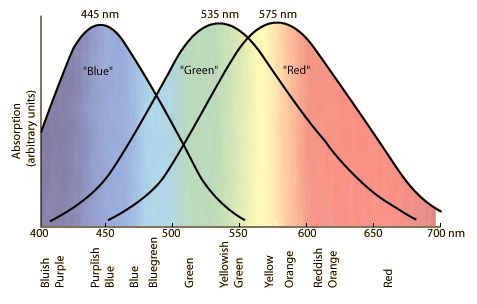Isaac Newton made a study of color starting at the age of 23 in 1666 and developed the useful Newton color circle which gives insight about complementary colors and additive color mixing. He realized that some colors (magenta, purple) could not be produced as spectral colors. One of his contributions was the idea that white light is light containing all wavelengths of the visible spectrum. He demonstrated this fact with experiments on the dispersion of light in glass prisms.
Thomas Young is credited with suggesting that the eye has three different kinds of color receptors, corresponding roughly with the red, green, and blue primary colors which had been found useful in matching a wide range of visual colors by additive color mixing. This idea was put on a more quantitative basis by Hermann von Helmholtz and is sometimes called the Young-Helmholtz theory.
Detailed experiments carried out in the 1920s showed that the RGB primaries could indeed match all visual colors within a certain range called a gamut, but that they could not match all the spectral colors, particularly in the green range. It was found that if a certain amount of red light was added to the color being matched, then all colors could be matched. The quantitative results were expressed in terms of tristimulus values for the RGB primaries, but it was necessary to allow negative values for the red tristimulus values in order to match all colors.
In 1931 the Commission International de l'Eclairage (CIE) moved to define a standard system in which all the tristimulus values would be positive and in which all visible colors could be unambiguously represented by two chromaticity coordinates x,y. Mapping the visual colors led to the now familiar horseshoe curve in the x,y plane known as the CIE chromaticity diagram. It is the basis for most quantitative color measurement at present.
It was not until about 1965 that the detailed physiological experiments were performed to measure the absorption of the different types of cones in the eye. Those experiments verified the postulate of Young that there were indeed three types of cones.
It would seem that we could now use something similar to the response curves of the three types of cones as color matching functions, but the CIE curves are well established as the standard curves. There are some strange things about the 1931 CIE standard chromaticity diagram. As Fortner and Meyer point out, it "devotes an enormous amount of real estate to various green shades" and less space to colors like the reds and purples which are more differentiable to the eye. In 1976, a new CIE standard was released which corrected some of those problems and produced a diagram where the distance between two points on the diagram was proportional to the perceived color difference. However, this 1976 CIE standard has failed to gain acceptance, and the 1931 CIE is almost universally used.

No comments:
Post a Comment